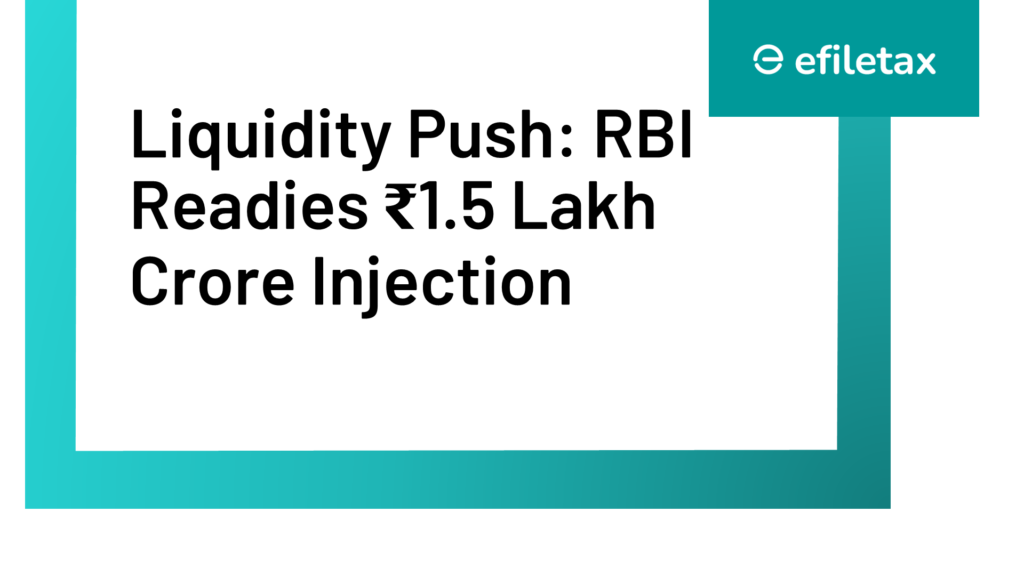
Introduction
In a bid to address liquidity shortages and ensure smoother economic operations, the Reserve Bank of India (RBI) has announced a significant liquidity infusion of ₹1.5 lakh crore. This initiative aims to stabilize financial markets, boost lending, and support sectors facing liquidity constraints. Such monetary interventions are vital for maintaining economic growth, especially in times of global financial uncertainty.
What is a Liquidity Injection?
Liquidity injection refers to the process where central banks introduce additional funds into the banking system to increase the availability of credit. It often involves tools like open market operations (OMOs), reducing repo rates, or purchasing government securities. This ensures banks have adequate cash reserves to meet demand and stimulate lending.
Why is the RBI Introducing ₹1.5 Lakh Crore?
The RBI’s decision to inject liquidity stems from several macroeconomic factors:
- Tightening Global Markets: Recent geopolitical tensions and monetary tightening in advanced economies have reduced liquidity flows to emerging markets like India.
- Addressing Festive Demand: The festive season often sees heightened cash withdrawals and increased consumer spending, creating higher demand for liquidity.
- Mitigating Inflationary Pressures: By maintaining liquidity, the RBI can ensure that credit flows to critical sectors without stoking inflationary pressures.
- Supporting Banking Sector Stability: Ensuring banks have adequate liquidity to manage credit demand and operational needs is crucial, especially for small and medium enterprises (SMEs) and retail sectors.
How Will the Liquidity Injection Work?
The RBI plans to utilize multiple tools to ensure the seamless injection of ₹1.5 lakh crore:
- Open Market Operations (OMOs): The RBI may purchase government securities to increase liquidity in the banking system.
- Repo Rate Adjustments: Lowering repo rates makes borrowing cheaper for banks, encouraging them to lend more.
- Term Repos and Auctions: Conducting term repos allows banks to borrow funds at fixed rates, ensuring temporary liquidity relief.
- Targeted Long-Term Repo Operations (TLTROs): This tool directs funds towards specific sectors like MSMEs, ensuring focused liquidity support.
Economic Impact of the Liquidity Push
1. Enhanced Credit Flow
Banks with additional liquidity will likely increase lending to businesses and individuals, boosting consumption and investments.
2. Support for Growth Sectors
Key sectors like infrastructure, manufacturing, and agriculture can access credit at lower interest rates, fueling growth.
3. Reduced Borrowing Costs
With increased liquidity, market borrowing rates are expected to decline, benefiting corporations and the government alike.
4. Strengthened Banking System
Liquidity support ensures that banks can meet cash withdrawal demands and maintain operational stability during peak periods.
Legal Perspective: Relevant Case Laws
Several court rulings highlight the role of liquidity measures in maintaining financial stability:
- Delhi High Court in Rohit Sharma v. Reserve Bank of India: The court underscored the importance of RBI’s proactive role in managing liquidity during economic downturns.
- Supreme Court in Indian Bankers Association v. Union of India: This case emphasized that liquidity injections ensure equitable credit access across industries and regions.
Challenges and Concerns
- Inflation Risks: An excess liquidity infusion could lead to inflationary pressures if not managed carefully.
- Short-Term Relief: Liquidity injections are temporary solutions and must be complemented by structural reforms to address long-term challenges.
- Sectoral Imbalance: Without targeted measures, liquidity might flow disproportionately, leaving key sectors underserved.
Conclusion
The RBI’s decision to inject ₹1.5 lakh crore is a timely and necessary step to stabilize India’s financial ecosystem. By addressing liquidity constraints and fostering economic growth, the central bank aims to safeguard the economy from global and domestic challenges. However, the effectiveness of this measure will depend on its implementation and complementary policy measures.